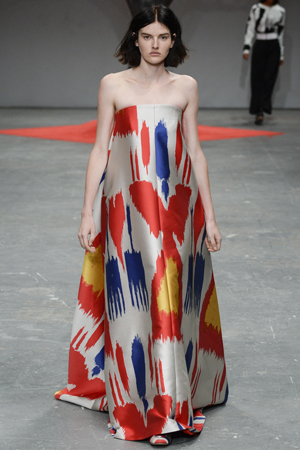 |
| Osman Yousefzada's ikat gown |
Although the origins of ikat are unknown, it is in Central Asia's Ferghana Valley that this weaving technique, practised and refined for generations, is flourishing.
Ikat differs from tie-dyeing in that the pattens are dyed onto the threads before the fabric is woven. (In tie-dyeing, the fabric is woven first and then the resist bindings are applied to the fabric which is later dyed).
British designer Osman Yousefzada's spring 2016 collection recently graced London Fashion Week.
In his trademark sculptural style, Osman's collection was striking. His pieces included bold evening gowns, mini dresses and shirts.
Over in New York, Reem Accra's gorgeous luxe evening wear had taken inspiration from suzani patterns.
Suzani derives from the Persian word for needle. However, for textile lovers, the word is synonymous with the glories of Uzbek embroidery. Stitched cooperatively by women and girls for centuries as part of their dowries, suzanis today remain a significant decorative and cultural art in Uzbekistan.
In home wares, ikat has moved beyond cushions and upholstery and is now decorating floors in gorgeous ikat and suzani patterned carpets.
Since Oscar de la Renta introduced ikat into his 2005 collection, Central Asian patterns have demonstrated remarkable staying power - undoubtedly because the beauty of the design and workmanship is timeless.
 |
| Josephine Keir Ltd suzani carpet |
Related posts: Ikat Porcelain Tableware
The Story of Uzbek Silk Production: Step by Step
Ferghana Valley Silk Ikats: Tying the Clouds
Symbols in Stitches: Uzbek Suzanis
Valentino Haute Couture Meets Suzani
Suzanis as Upholstery: the Brilliance of Bokja Design
The Silk Road Inspires Piaget's Secrets and Lights Collection
The Fantasy World of Uzbek Textile Artist Dilyara Kaipova